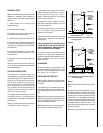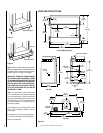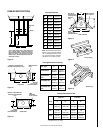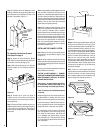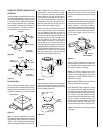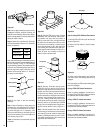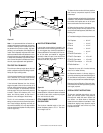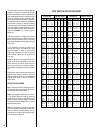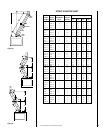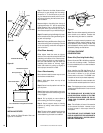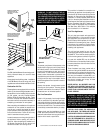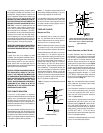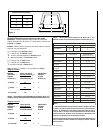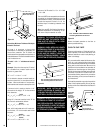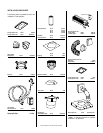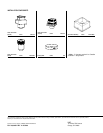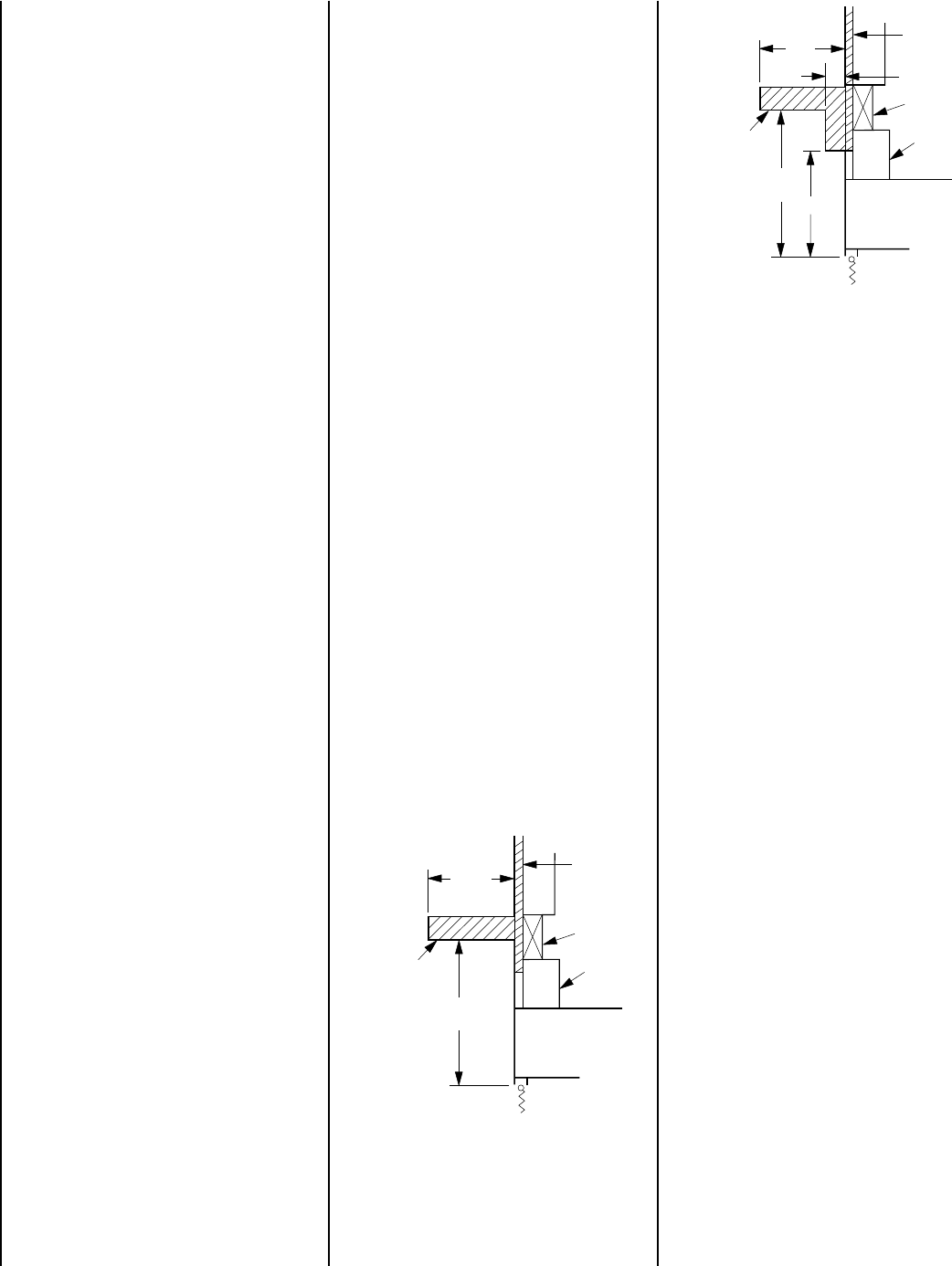
NOTE: DIAGRAMS & ILLUSTRATIONS NOT TO SCALE.
16
Note: A 1"* air space must be preserved for all
combustible materials extending for any con-
tinuous length adjacent to the chimney.
It is especially important to insulate between
the studs of an outside chase cavity and under
the floor if the floor is above ground level. Do
not place insulation directly against the fire-
place or chimney system.
FIREPLACE FINISHES
Mantels and Trim
It is sometimes best to frame your fireplace
after it is positioned and the chimney is in-
stalled. Frame enclosure for chimney and fire-
place with 2 x 4’s (or heavier) lumber.
Note: The header may rest on the two (2) metal
top spacers on top of the unit but the header
must not be notched to fit around the spacers.
These fireplaces may sit directly on a combus-
tible surface. A 1"* air space is required be-
tween combustible framing and the chimney.
A 1" air space is required between combus-
tible framing and fireplace outer wrapper. In
Canada, the minimum height for a combus-
tible mantel is 18" (457 mm) above the fire-
place opening.
Figure 45
shows typical Cana-
dian installations. Combustible mantels and
trim may be installed 12" above the fireplace
opening as per NFPA 211, Section 7-2.3.3. and
Figure 46
. If a mantel is of a noncombustible
material, it is exempt from these requirements
as long as it does not interfere with the instal-
lation or operation of glass doors.
*Note: 2" clearance to combustibles required
in Canada.
Figure 46
If you’re installing a gas line, connect it before
the fireplace is framed and enclosed in the
finished wall. The gas knockout is determined
by the indentation located at the bottom and
slightly off center in the side refractories. THE
KNOCKOUT IS ALWAYS REMOVED FROM IN-
SIDE THE FIREPLACE. DO NOT REMOVE THE
KNOCKOUT UNLESS YOU ARE INSTALLING A
GAS LINE. If removal is attempted from the
outer wrapper, side refractory damage may
occur. With a medium-sized hammer, lightly
tap the surface of the indentation. The refrac-
tory material is very thin in this area and is easily
removed. Once a small hole has been made,
continue tapping until you have reached suffi-
cient diameter for the gas line to fit through. The
entire knockout does not have to be removed.
Remove insulation in the gas line channel.
IMPORTANT: REPACK INSULATION MATERIAL
IN SQUARE HOLE AROUND GAS LINE, INTE-
RIOR AND EXTERIOR OF FIREPLACE, TO SEAL.
Glass Doors
If glass doors are to be installed on these
fireplaces, refer to specific installation instruc-
tions packed with the glass doors. Use only the
doors that are listed for use with these fire-
places. Use of other non-listed glass door on
these fireplaces may constitute a potential fire
hazard and is not recommended.
CAUTION: CERTAIN GLASS DOORS OVERLAP
THE BLACK METAL FACING OF THE FIRE-
PLACE. IF THE FIREPLACE HAS BEEN FACED
WITH NONCOMBUSTIBLE MATERIALS, THERE
MIGHT NOT BE SUFFICIENT CLEARANCE TO
INSTALL THE GLASS DOORS OF YOUR
CHOICE. ENSURE ADEQUATE CLEARANCE IS
MAINTAINED AT ALL TIMES SO AS NOT TO
INTERFERE WITH THE INSTALLATION AND
OPERATION OF GLASS DOORS.
COLD CLIMATE INSULATION
If you live in a cold climate, it is especially
important to seal all cracks around the fireplace
opening with noncombustible material and
wherever cold air could enter the room. Sur-
rounding materials must be caulked where it
meets the black metal facing of the fireplace to
avoid cold air intrusion.
Use noncombustible caulking material only on
fireplace facing to seal. Also, the outside air inlet
duct should be wrapped with noncombustible
insulation to minimize the formation of conden-
sation. Do not place insulation materials on top
of fireplace or against chimney sections.
12"*
Min.
8"*
Fireplace
Opening
Spacer
Combustible
Mantel
and Trim
12"
Max.
1 1/2"
Finished
Wall
Typical Installation
Header
*Both Of These Dimensions Must Be At Least 18”
When An Unvented Gas Log Set Rated At 26,000
BTU Or Higher Is Used. (Maximum 40,000 BTU)
Figure 45
Fireplace
Opening
Spacer
Combustible
Mantel
8" Max.
(203mm)
Finished
Wall
Canadian Installation
Header
18" Min.
(457mm)
Hearth Extensions and Wall Shields
A hearth extension must be installed with
all fireplaces. It is to protect the combustible
floor in front of the fireplace from both radiant
heat and sparks. The hearth extension must
extend 8" beyond both sides of the fireplace
opening and 16" beyond the front (
see Figure
47 )
. Use a hearth extension constructed of a
durable noncombustible material having an
equal or better (lower k value) insulating value
of k = .84 BTU IN/FT
2
HR °F or a thermal
resistance that equals or exceeds r = 1.19 HR
°F FT
2
/BTU IN. With these values, determine
the minimum thickness/material required us-
ing the formula and
Page 17
.
Note: Any noncombustible material whose k
value is less than .84 or whose r value is more
than 1.19 is acceptable.
If the fireplace is installed on a combustible
floor, use the metal safety strips (provided)
on the floor extending half under the fire-
place and half under the hearth extension
(refer to
Figures 6 & 7)
.
A wall shield is required where a continuous
perpendicular side wall is within 12" of the
fireplace opening (
Figure 48 )
. Use a 36" W x
36" H wall shield constructed of a durable,
noncombustible material having an equal or
better (lower k value) insulating value than k =
.54 BTU IN/FT
2
HR °F. At no time may a
perpendicular side wall be located closer than
9" from the fireplace opening.
If fireplace is installed diagonally across a 90°
corner; no wall shields are required.



